Thirsty Cities Drill for Water
When reservoirs drop, cities turn to groundwater.
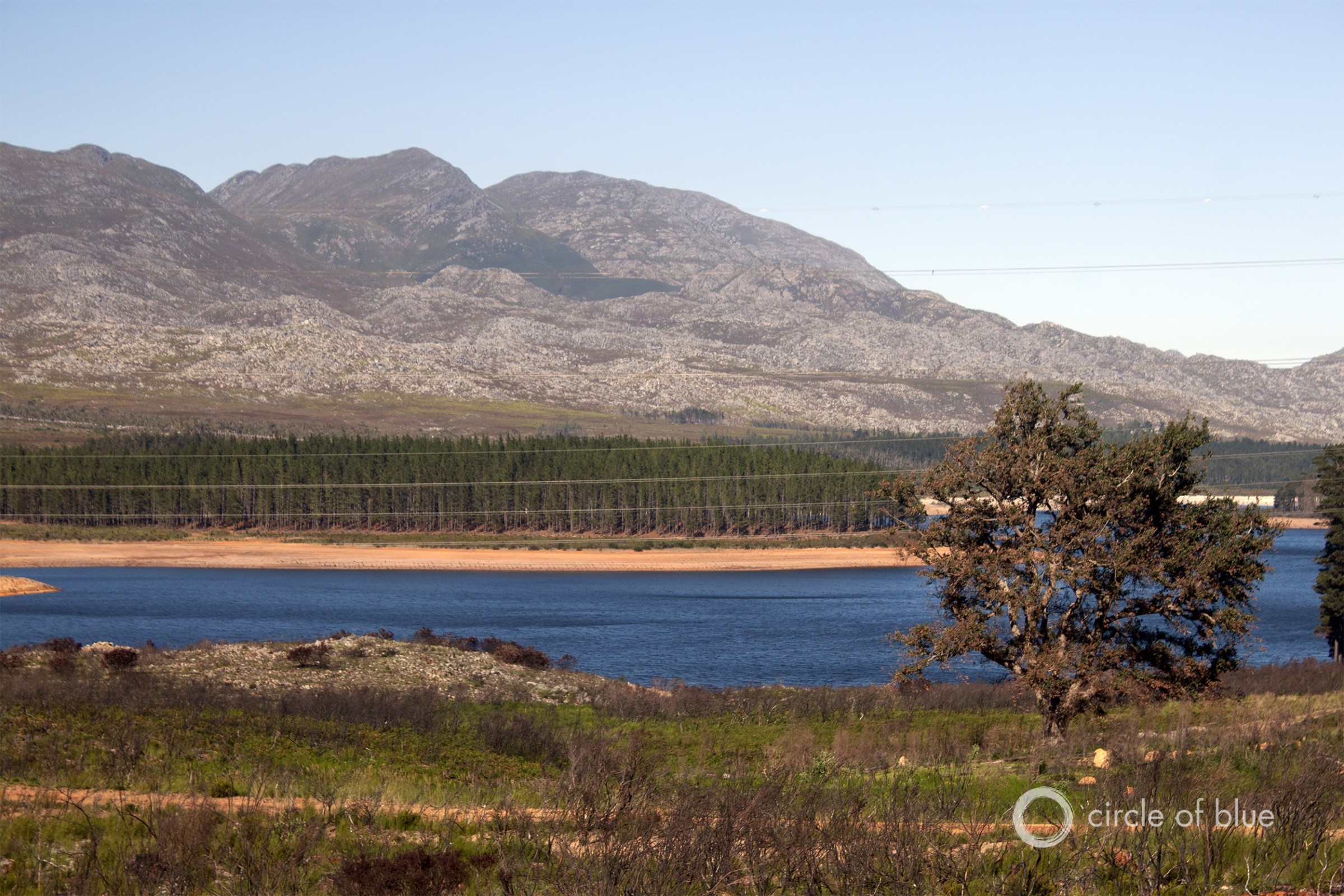
Steenbras Dam, east of Cape Town, is the site of exploratory groundwater drilling. Photo © Brett Walton / Circle of Blue
By Brett Walton, Circle of Blue
Travel funding for this story came from the Pulitzer Center on Crisis Reporting
CAPE TOWN, South Africa — In the mountains east of the city, just beyond the curving road up Sir Lowry’s Pass, workers maneuver heavy machinery to stab at the ground near Steenbras Dam, drilling deeply with steel pipes to bring forth water.
They are trying to tap into the Table Mountain Group aquifer, which holds water in a vast lattice of narrow rock fractures beneath the Cape Fold mountains that ring the city. Cape Town has eyed the aquifer as a water source for nearly two decades, but plans were accelerated during a three-year drought in which reservoirs shriveled to the point that Mayor Patricia De Lille threatened to shut off water to homes and businesses, a doomsday scenario branded as Day Zero.
Cape Town, which wants to diversify its water sources beyond reservoirs, is not the only municipality on a subterranean quest. In increasingly dry conditions, cities from Australia and the Middle East to the American Southwest are pursuing groundwater, either as an integral piece of their future water supply or as an emergency stopgap measure.
Los Angeles, looking long-term, aims to double the share of its water supply that comes from groundwater by 2040 and cut reliance on distant and shrinking sources like the Colorado River. Las Vegas, which also uses the Colorado River, has attempted for nearly three decades to acquire rights to groundwater from spring-fed valleys some 300 miles (480 kilometers) north. For Sin City, groundwater rights, which are fiercely contested by environmental groups, ranchers, and valley residents, are a hedge against a declining Lake Mead, currently just above its record low. The big Colorado River reservoir is Las Vegas’s only water source.
In the Australian state of New South Wales, where rainfall deficits over the last year and a half are among the largest on record, reservoirs are also front of mind. Storage plunged by 40 percent in the last 12 months. The inland town of Murrurundi, some 185 miles (300 kilometers) north of Sydney, instituted strict water-use limits in July, and today its main reservoir is below 30 percent of capacity. Once the dam drops below 20 percent, accumulated sediments will make the water increasingly difficult to use, says Philip Hood, manager of water and sewer for the Upper Hunter Shire Council, the regional governing body.
With no rain and at current use, one thousand residents will be out of water in less than 70 days, according to Daele Healy, communications officer for the council.
That is an unacceptable outcome, so Murrurundi is looking to groundwater to supplement the reservoir until a pipeline connecting the town to a larger city’s water system is completed in 2020.
“It won’t take us off restrictions,” Healy told Circle of Blue about the groundwater plan. “But we won’t need to truck in water.”
Increasing Pressure on Groundwater
To satisfy growing water demands, global groundwater use has soared in recent decades — but not all of the growth is sustainable. A 2014 study published in the journal Water Resources Research found that, based on satellite data, the rate of groundwater depletion — meaning more withdrawals than deposits — has doubled since the last decades of the 20th century, largely due to agriculture. The problem spans continents. Most of the world’s largest aquifers registered deficits in the previous decade, according to a 2015 study from the University of California, Irvine that also used satellite data.
That does not mean that any particular site is being managed unsustainably. But it does indicate a worrisome international trend. Evidence is everywhere.
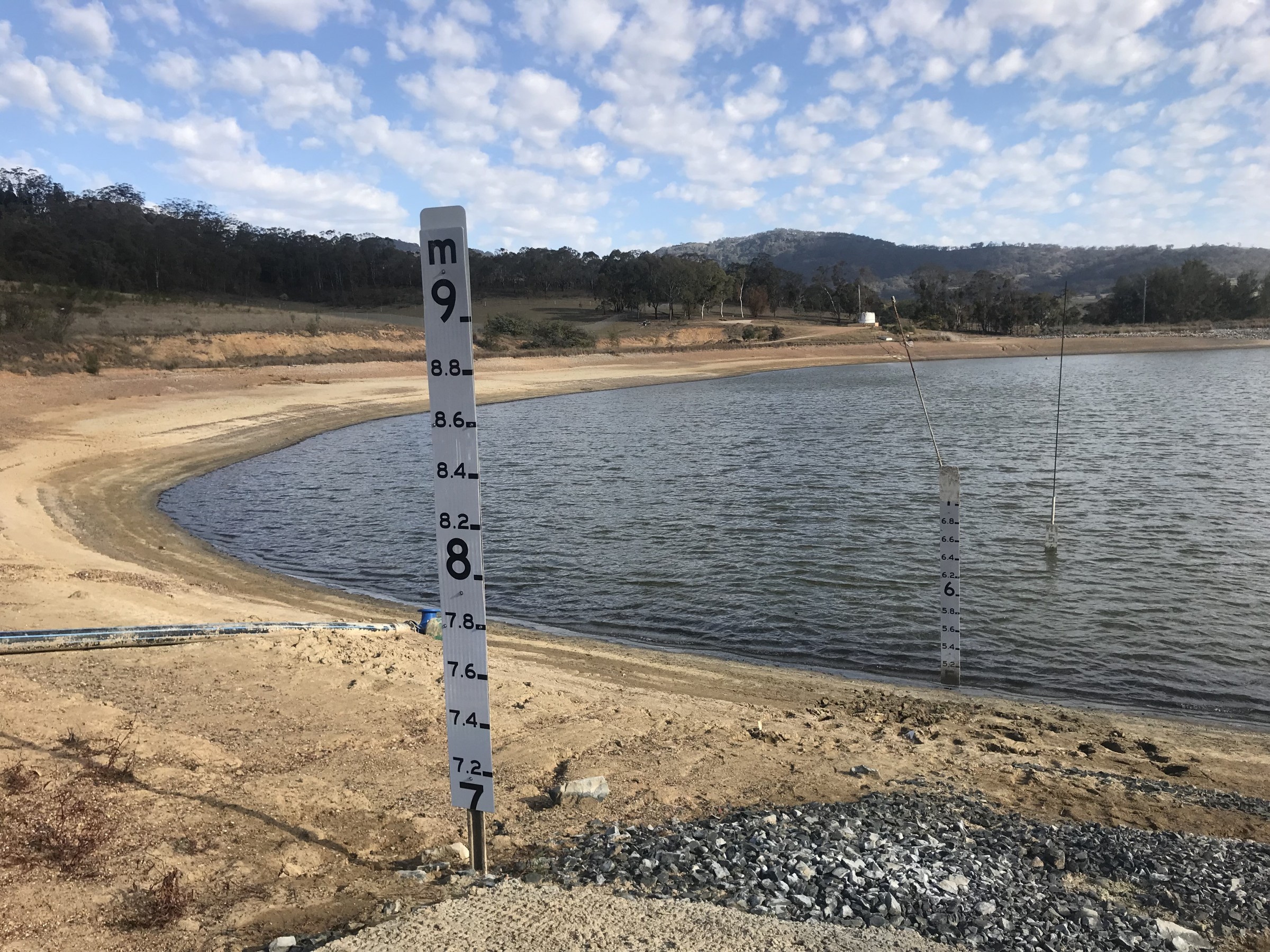
The dam that supplies the Australian town of Murrurundi is below 30 percent of capacity. Photo courtesy of Upper Hunter Shire Council
Groundwater depletion in India is so severe that Nitin Gadkari, the water minister, says the country is facing the “worst water crisis” in its history. Much of the deficit is due to rampant farm irrigation — India pumps more groundwater, and more groundwater for farming, than any other country — but some urban centers have so depleted their water tables that earlier this year India’s top environmental court ordered the Delhi government to shut down all illegal wells in the city.
Other megacities — Bangkok, Jakarta, Hanoi, Mexico City, and Tehran for instance — are sinking in areas where too much groundwater has been pumped.
The reason groundwater is so desirable is as true for cities as it is for farmers: groundwater is often the cheapest, most readily available option, especially in a time of immediate need. Despite talk of large facilities to remove salt from the ocean and of reusing sewer water, groundwater is the “best value of money” for Cape Town to bolster its water supply, argues Christine Colvin, a freshwater specialist with WWF-South Africa.
City of Cape Town numbers back this up. Per unit of water, tapping the three local aquifers — the Atlantis, Cape Flats, and Table Mountain Group — is at least two to four times cheaper than water from a desalination plant.
Wastewater recycling and desalination are proven technologies, but are more costly and slower to build. Groundwater generally represents a quicker solution, particularly for individuals and businesses who want to wean themselves from municipal water. Drilling companies working in Cape Town reported being booked for months at the height of the Day Zero panic. City authorities now count more than 26,100 registered household boreholes in the city, mostly in wealthier districts.
Businesses, too, looked underground to outlast the drought. ACA Threads, a manufacturer of sewing thread, plans to switch to groundwater to run its production facility on the outskirts of Cape Town, said Chris Handt, operations manager. The company invested in two boreholes that produce enough water to cover all the facility’s needs. It will remain connected to the municipal system, but only for emergency purposes.
Handt told Circle of Blue that ACA will offset some of its pumped water by redirecting rainwater that normally flows into storm drains into an on-site recharge basin. Handt did not know how effective the recharge plan would be.
Moving Slowly
For Cape Town itself, groundwater was expected to be the quickest means of augmenting its water supply, but that has not been the reality. Fortunately, a heroic water conservation campaign and soaking rains in June helped Cape Town avoid a Day Zero catastrophe. Its reservoirs are now more than 70 percent full. The national government did not renew the drought disaster designation in June, and the city announced it will start relaxing water use restrictions on October 1.
Earlier this year, city officials said they anticipated, in an optimistic scenario, pumping 100 million liters of groundwater a day by October from the three aquifers. They have fallen far short. Twelve million to 15 million liters a day is being pumped, only from the Atlantis aquifer.
Ian Neilson, the executive deputy mayor, lists a number of factors for the slow progress on the Cape Flats aquifer: access to land for drilling, poorer water quality than was expected, and the need to guard the wells against contamination.
The city had to acquire licenses from the national Department of Water and Sanitation to extract groundwater. The license for the Cape Flats aquifer requires the city to replace a portion of the water it pumps out. Recharge is possible because the Cape Flats, near the coast, is a sandy, alluvial aquifer into which water easily filters.
The Table Mountain Group, however, is a fractured rock aquifer, where water flows between innumerable below-ground pathways. City-operated recharge sites are not feasible here.
Understanding these systems — and how pumping will alter ecology and hydrology — requires precise knowledge. Though they are useful for uncovering global and regional trends, satellite data are not sharp enough to reveal groundwater dynamics for particular wells or catchments. For local management, local data about subsurface flows, recharge rates, and water chemistry are needed.
“Emergency groundwater supplies will experience the longer-term effects of the drought, so after the drought the aquifer will need extra time to recover,” Claudia Ruz Vargas, a researcher with the International Groundwater Resources Assessment Center, told Circle of Blue.
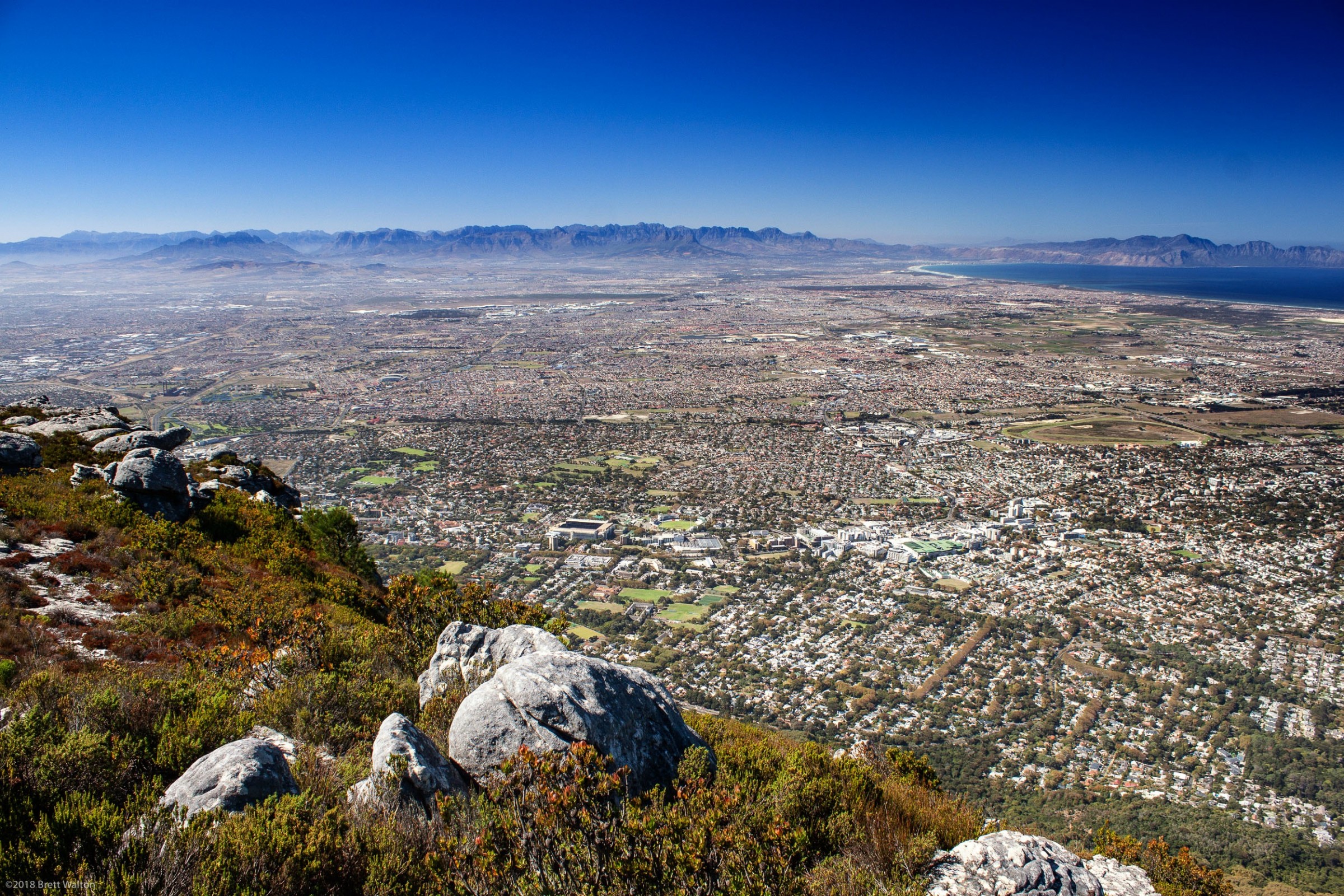
Sprawling east from Table Mountain, the Cape Flats are home to many of the city black and poorer residents. Photo © Brett Walton / Circle of Blue
The potential unintended consequences of Cape Town’s plan to tap the Table Mountain Group worry Jasper Slingsby, an ecologist with the South African Environmental Observation Network. Slingsby studies the fynbos vegetation of the Cape Floral Region, a biodiversity hotspot recognized by UNESCO as a World Heritage site for its multitude of unique species. The region is home to some 9,000 plant species, two-thirds of which grow nowhere else.
“The fynbos is full of narrow, endemic, weird species that depend on that habitat,” Slingsby told Circle of Blue about the areas of mountain catchments that are nourished by groundwater that seeps out of rock layers. “Knowing if the habitat is linked to sites where they’re abstracting water is difficult.”
Neighboring cities like Stellenbosch are also drilling in nature reserves for groundwater.
Slingsby is part of an environmental working group that Aurecon, a contractor, is organizing on behalf of Cape Town. Since the first meeting in March, Slingsby said that the city has become more responsive to questions about its groundwater plans. The city aims to develop wells with maximum water yield, but the working group is tasked with helping to screen borehole sites at seven Table Mountain Group areas for potential ecosystem damage.
The working group has submitted recommendations to the city regarding the borehole locations at Steenbras, the location of a city-owned reservoir. The other areas are still being evaluated, Jeanne Louise-Wiese of Aurecon told Circle of Blue.
The World Heritage Committee, in July, noted its own concern about whether the city’s drilling plan would endanger the mountain ecology. During the drought emergency, the city’s groundwater program received an exemption from national environmental reviews in order to bring water online faster. (A consultant’s report in October 2014 said that exploratory studies, licensing, and environmental review would take three years for a large-scale Table Mountain Group groundwater project.)
Other observers argue that Cape Town could do more itself to boost underground water storage. Invasive plants — Monterey pine, acacia, and black wattle — in the mountain catchments steal water before it can reach the aquifer. Removing those, the thinking goes, is a win-win for native ecosystems and water supply. A 2016 study estimated that invasive plants, which continue to spread, capture about 7 percent of the average runoff from the fynbos region. The study author noted that the estimate was conservative.
“It’s not a problem we can ignore because if we ignore it, it will get worse,” Colvin of WWF-South Africa said.
Within the metropolitan area, urban growth patterns are misaligned with the “water smart” image that Cape Town likes to project, according to Kevin Winter, director of the University of Cape Town’s Future Water Institute. The city is expanding outward in waves of concrete and pavement, hard surfaces that prevent rainwater from soaking into the ground.
“It doesn’t look like we’re embracing the compact city idea at all,” Winter said.
Cape Town officials, Winter explained, should view the land within city limits as part of the water catchment, too.
Brett writes about agriculture, energy, infrastructure, and the politics and economics of water in the United States. He also writes the Federal Water Tap, Circle of Blue’s weekly digest of U.S. government water news. He is the winner of two Society of Environmental Journalists reporting awards, one of the top honors in American environmental journalism: first place for explanatory reporting for a series on septic system pollution in the United States(2016) and third place for beat reporting in a small market (2014). He received the Sierra Club’s Distinguished Service Award in 2018. Brett lives in Seattle, where he hikes the mountains and bakes pies. Contact Brett Walton

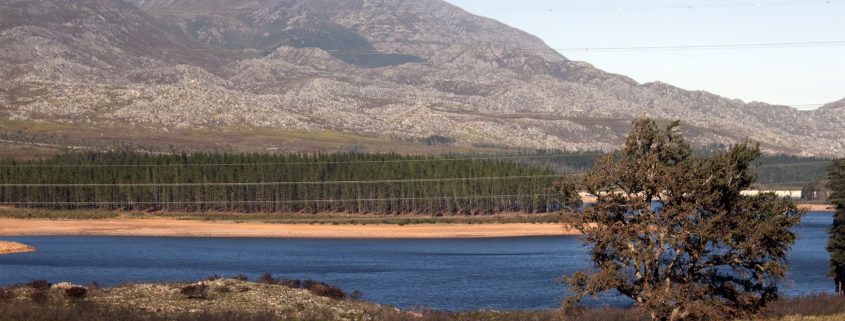


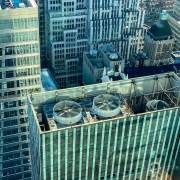





Leave a Reply
Want to join the discussion?Feel free to contribute!